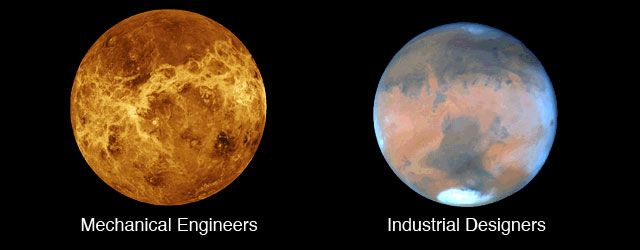
It is widely acknowledged that professionals working in the field of Industrial Design tend to “see the world differently” from those of us whose focus is classic mechanical engineering.
We recently saw an entertaining video (below) which in a minute or so sums up a lot of the elements that the Industrial Design discipline incorporates. They chime with many of the principles of great design of which we have written about in previous posts.
To try and explain the difference between the two camps – Industrial Designers and Mechanical Engineers – it is helpful to look at the two sides of the engineering design coin, namely form and function.
The ‘form’ bit is the traditional domain of the Industrial Designer – a simple description that takes in a gamut of specialities described in the video and covering areas such as aesthetics, ergonomics and other human factors like user experience (UX). Professionals in this area tend to be at the creative end of the spectrum and can be considered more “artisan” in that they are practitioners of a craft during which through aptitude they may reach the expressive levels of an artist.
The classical mechanical engineer lives more in the ‘function’ domain and this is where Warley Design is particularly strong. We have a solid back-ground in the engineering of products to assure reliable function to all regulatory or customer specified specifications and can be more procedural and rule-driven. Mechanical engineers are often guilty of having their thinking overly constrained by mere laws of physics, economics practicality!
With both directors having served craft apprenticeships we are able to uniquely blend this with hands-on experience working in manufacturing environments, enabling us to create fully considered designs that meet our customer’s technical and commercial goals and are optimised for the most appropriate manufacturing processes. It is only through this process of designing for a specific manufacturing process can the design be optimised for the lowest cost at the projected volumes.
The deep routed differences between mechanical engineers and Industrial Designers has led to some traditional tribal grouping into these two camps over time. Ultimately, which camp takes a lead role on a project comes down to the nature of the product. If the product is a new camera or a smart phone then the Industrial Designer will play a major role, especially on the parts where there is human interaction. Designs for a new lunar lander module on the other hand will be exclusively about function and performance, hence this is the type of project that Warley Design would relish.
But there are many examples of where the two disciplines complement each other to achieve highly successful results. Think of a classic Alfa-Romeo to represent Industrial Design, a reliable old Land Rover representing Engineering Design and now think Aston Martin DB9 to represent the best of both worlds. They are brilliantly engineered vehicles that not just perform fantastically but are also beautiful places to interact with or just to behold.
Good engineering design need not come at a price, though. With commodity products it is far more important that appropriate consideration is given to materials, processes and tooling in the very early stages of a development, as this ultimately shapes the very concept, determines the cost and influences the end-user’s perception of quality. Getting this balance just right requires a multi-disciplinary approach and one where Engineering designers and Industrial Designers both have a contribution to make.
Warley Design offers mechanical design, engineering and product development services to a broad range of industries. If you have a development programme that we can help you with please contact us.